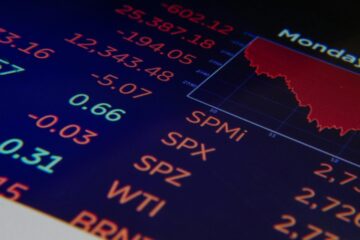This article is the follow up to “How to Manipulate the Bitcoin Market (1/3)”.
In the second part, we want to show how the spikes in price between the end of May and the first half of June 2016 were the result of just a few investors who used huge leverage to strengthen their position. Our hypothesis is that some market players took advantage of the 20x leverage (described in the part 1) to artificially inflate futures’ price and squeeze out small investors.
Source: bitcoinwisdom.com
The graph above is a daily chart of BFX spot prices between May and July 2015: overall, there has been an 82% increase between the minimum of 433 USD and the maximum of 789 USD. At the same time on OKC spot prices, there has been a sharp increase of 87% between the minimum of 2,773 CNY and the maximum of 5,185 CNY, but with movements of higher amplitude and drawdown.
To analyse the first spike in price we look the average rate on active USD/BTC Margin Funding and the total sum of active USD/BTC Margin Funding. The average rate is the rate that margin traders are paying daily to borrow funds, while the total sum is self-explanatory and is the total amount borrowed. For instance, a trader going long on BTCUSD will borrow USD, thus increasing the average rate on USD Margin Funding and the total sum of active USD funding. On the other hand, a trader going short on BTCUSD will borrow BTC to sell, hence increasing the average rate on BTC Margin Funding and the total sum of active BTC funding.
Souce: bfxdata.com
Source: bfxdata.com
In the second chart, you can see how the short positions have accumulated during the week between 19th and 27th of May. The next day huge leveraged buys started taking place on BFX and the average rate to borrow USD funds went from 0.04% a day to 0.17% a day at its peak and the total sum of USD borrowed increased by 5 million of USD. Market price stood around 550 USD at the end of the week. At the same time on OKC someone was holding 68,000 open futures contracts, implying a long position, otherwise with a price increase like this and so high leverage, it would have surely been margin called if it was short position.
For what concerns the second spike, between 11th and 20th of June, the price of BTC went up from 573 USD to 789 USD, an absolute return of 37.7%, coming from another 27.8% in the previous period. Sharp variations are common for a volatile asset such as BTC. However, the events of such magnitude are uncommon.
The market movers that we spotted in our analysis are few very large investors that operated through the futures market; this market is flourished since it provides a good deal of anonymity, it minimizes information leakage as only the number of open contracts is published. The use and abuse of leverage (as much as 20x) makes these instruments very dangerous and the favourite tools by aggressive traders. Using the lending rate as indicator, we can observe how the open Total sum of active USD Margin Funding went from 29 million USD on the 11th of June to 43 million USD (the green line in the next chart).
Source: tradingview.com
The upward trend was a rough wake for bears and many short positions were margin called as it is evident from the decreasing cost of borrowing BTC (when short positions are closed, there are more BTC available from margin financing and the rate of borrowing BTC goes down).
After this strong movement, they faced a difficult choice: close their short buying BTC or provide ulterior margin to their position?
The movement shown no sign of stopping and short positions had to be closed which added momentum to the move, but not for too long. The next day, on the 21st of June price reverted when bears started playing the leveraged game and used big amount of BTC as collateral to open short positions up to 14,000 BTC (nearly 10 million USD at that moment).
How can we trade in such environment where it looks like only big investors can profit?
In the next graph, we plot the spread between the Quarterlies futures (3 months from spot delivery) and the spot price (the spread is zero on the green line).
Source: BSIC
The formula to price futures is F(0)=S(0) e^(rT).
Perhaps the most important factor is r, which is influenced by various elements:
- Risk free rate
- Cost of storage
- Convenience yield
In our analysis for the sake of simplicity and relevance, we assume r as being only the risk free rate. We assume zero storage cost and zero convenience yield as BTC is a digital asset and brings no benefit in holding it. In traditional asset classes, it is common practice to consider the yield on the short-term government bonds as a risk free rate; here such benchmark does not exist, as there are no BTC-denominated bonds. The risk free rate will be the average rate at which liquidity providers are lending BTC; as a result, this rate is always positive.
Futures and spot trade at the same price level only at expiration or when r = zero; in all the other cases they differ and the spread between them tend to be zero when t -> T (convergence between futures and spot).
In our trade setup, we monitor Quarterlies and spot prices; we enter into a trade when Quarterlies are trading lower than spot, going long the Quarterlies and shorting the spot. This strategy is independent from price and is equivalent to longing the rate r when r < 0. It could prove to be a very profitable trade if executed properly but to do so, first, we go through a brief transaction cost analysis.
On Quarterlies we can leverage our position up to 20x, on spot only 5x so we need to balance our position accordingly. OKC offers free trading so our work is really simplified in this case as we have to consider only the bid-ask spread, the cost of borrowing and the risk of slippage.
To exploit in a better way the short timeframe in which this opportunity is available, it is better to implement an algorithm that does the job for us and makes the execution automatic, faster and flawless trough OKC Application Program Interface (APIs).
Of course as all the trades, this is not free from risk. In fact, here we are betting that the spread between Quarterlies and spot will turn positive again. It could happen that another market player with huge long futures position gets margin call right after we enter into the trade. His liquidation of Quarterlies would push the spread further into negative territory, triggering a margin call for us as well.
A computer-generated simulation showed that the larger our position was on this strategy, the more risk we would bear.
Next week we will see another example of how easy it is to manipulate assets with low market capitalization. Moreover, we will focus on another market and provide practical examples.
[edmc id= 4145]Download as PDF[/edmc]








1 Comment
Wdowiak · 27 January 2024 at 16:33
I guess, your trade is to bet the return of the future curve from backwardation to contango ! Why not